
The reticulated python is a snake species in the family Pythonidae native to South and Southeast Asia. It is the world's longest snake and listed as Least Concern on the IUCN Red List because of its wide distribution. In several range countries it is hunted for its skin, for use in traditional medicine and for sale as a pet.
The Furongian is the fourth and final series of the Cambrian. It lasted from 497 to 485.4 million years ago. It succeeds the Miaolingian series of the Cambrian and precedes the Lower Ordovician Tremadocian stage. It is subdivided into three stages: the Paibian, Jiangshanian and the unnamed 10th stage of the Cambrian.
Crotaphytus reticulatus, commonly called the reticulate collared lizard, is a species of moderately sized lizard in the family Crotaphytidae. The species is native to semiarid, rocky regions of the Tamaulipan mezquital. Its range includes the American state of Texas and the Mexican states of Coahuila, Nuevo León, and Tamaulipas. Of all the species in the family Crotaphytidae, C. reticulatus is the only species which is not restricted to rocky habitats.
The Paibian is the lowest stage of Furongian series of the Cambrian. It follows the Guzhangian and is succeeded by the Jiangshanian stage. The base is defined as the first appearance of the trilobite Glyptagnostus reticulatus around 497 million years ago. The top, or the base of the Jiangshanian is defined as the first appearance of the trilobite Agnostotes orientalis around 494 million years ago.

Boletus reticulatus, and commonly referred to as the summer cep is a basidiomycete fungus of the genus Boletus. It occurs in deciduous forests of Europe where it forms a symbiotic mycorrhizal relationship with species of oak (Quercus). The fungus produces fruiting bodies in the summer months which are edible and popularly collected. The summer cep was formally described by Jacob Christian Schäffer as Boletus reticulatus in 1774, which took precedence over B. aestivalis as described by Jean-Jacques Paulet in 1793.

Elaeocarpus reticulatus, the blueberry ash, is a large shrub or tree which can grow to a height of 15m. In New South Wales (NSW) rainforests it can attain a height of 30 metres. Its most conspicuous features are white or pink cup-shaped flowers with fringed edges and round blue fruits. Strictly botanically, the fruits are not true berries but drupes. Blueberry ash also has leaves which turn bright red as they get older.

The Asian sheepshead wrasse, Semicossyphus reticulatus, is a species of wrasse, one of the largest, native to the western Pacific Ocean, where it is only known from Korean Peninsula, China, Japan, and the Ogasawara Islands, where it inhabits rocky reef areas. It can reach 100 cm (39 in) in total length and the greatest weight recorded for this species is 14.7 kg (32 lb). This species is valued as a food fish in its native range.
Chiloglanis reticulatus is a species of upside-down catfish native to the Dja River system in Cameroon and the Luala and Lufu River drainages in the Democratic Republic of the Congo. This species grows to a length of 4.2 centimetres (1.7 in) SL.

Orectolobus reticulates, the network wobbegong, is a recently described species of carpet shark found in relatively shallow waters off Kimberley and Darwin in north-western Australia. With a known maximum length of only 52.3 centimetres (20.6 in), it may be the smallest species of wobbegong. Until its description in 2008, it had been confused with the northern wobbegong.

Oreaster reticulatus, commonly known as the red cushion sea star or the West Indian sea star, is a species of marine invertebrate, a starfish in the family Oreasteridae. It is found in shallow water in the western Atlantic Ocean and the Caribbean Sea.
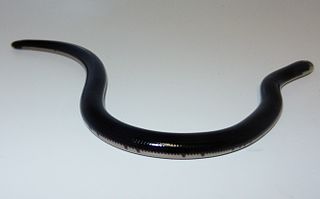
The reticulate worm snake is a species of snake in the Typhlopidae family. The snake has been reported in Colombia, Peru, Bolivia, Brazil, the Guyanas and Venezuela.

The mailed butterflyfish is a species of butterflyfish found at depths of from 1 to 30 metres on reefs in the central and western Pacific Ocean. It grows to a length of 18 centimetres (7.1 in) TL and can be found in the aquarium trade. It is also of minor importance to local commercial fisheries.

The spotfin burrfish, also called the spotted burrfish, Pacific burrfish, spotfin porcupinefish, few-spined porcupinefish, spotfin porcupinefish or few-spined porcupinefish, is a species of fish in the genus Chilomycterus, which is part of the porcupinefish family Diodontidae.

Glyptagnostus reticulatus is a species of agnostid trilobite belonging to the genus Glyptagnostus. It existed during the Paibian Age of the Cambrian. It has a cosmopolitan distribution and is an important index fossil in biostratigraphy. It was characterized by an unusual net-like pattern of furrows on both the cephalon and the pygidium.
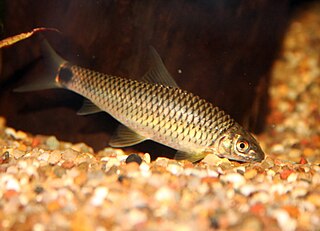
Crossocheilus reticulatus is a freshwater fish in the family Cyprinidae from Southeast Asia. It grows to 17 cm (6.7 in) standard length.
Camponotus reticulatus is a species of carpenter ant. It is found from many Afrotropical, Indo-Australian, Oriental, Palaearctic regional countries.
Freocrossotus meridionalis is a species of beetle in the family Cerambycidae. It was described by Stephan von Breuning in 1977. It is known from South Africa.
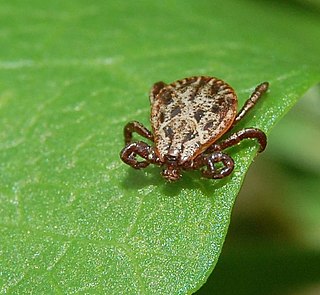
Dermacentor reticulatus, also known as the ornate cow tick, ornate dog tick, meadow tick and marsh tick, is a species of tick from the family Ixodidae. It is the type species for the genus Dermacentor.
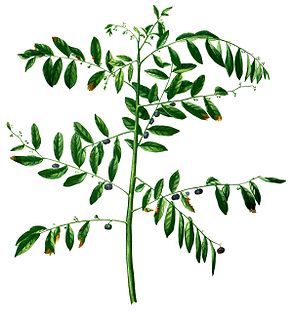
Phyllanthus reticulatus is a plant species described Jean Louis Marie Poiret; it is included in the family Phyllanthaceae.
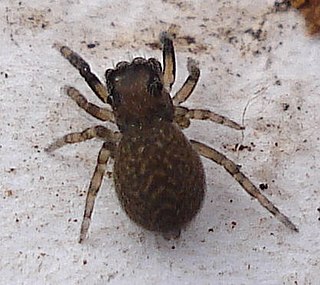
Neon reticulatus is a species of jumping spider in the family Salticidae. It is found in North America, Europe, Turkey, Caucasus, a range from Russia (European to the Far East, Kazakhstan, Korea, and Japan.
















